At one time or another, most chicken-keepers have experienced the inconvenience of having to chase, coax, cajole or otherwise escort a new flock member into the coop at dusk, which is no fun for us, or them. Chickens do not manage stress well and moving from one housing arrangement to another is extremely stressful for chickens, whether from a brooder to a coop or from one backyard to another. How they manage that stress will vary from chicken to chicken, but it often results in confusion about where ‘home’ is and where they should sleep at night.
There is a way to teach chickens to roost inside the coop- I refer to it as Coop Training. Coop Training can be done with chickens of any age but the younger, the better. It is far easier to teach good habits from the beginning than it is to try to break bad habits later. For this reason, I always Coop Train young and new flock members.
THE COOP TRAINING METHOD
**An important safety note: Coop Training should never be done when the temperatures inside the coop exceed 70° F.**
Confine chickens to the coop with no access to the run for at least a week. This reinforces the concept of ‘home’ and they have no choice but to roost inside the coop.
Week two, open the pop door and allow them to venture out into the run if they wish, but do not interfere if they would rather not. In the unlikely event they do not return to the coop at dusk that first night, they need more time confined to the coop. In another week, try again. (I have never had to resort to adding on a second week.)
If allowing the flock to free-range, week three is the time to open the door to the run and let them explore the great outdoors. They will likely remain in close proximity to the coop and run and will return to roost at night.
I discovered the concept of Coop Training quite by accident. My first dozen chickens to occupy the coop never required chasing or encouragement to roost inside the coop at night, but when I added the first of many subsequent flock members to the coop, I found myself coaxing chickens off the roof or from underneath the coop after dark.
In contemplating the differences between the two groups of chickens, I realized that that my first dozen chicks were not allowed into the run for several weeks after they took up residence in the big girl coop. The second group of chickens were stressed by the move from brooder to coop as is to be expected. The newbies were also disoriented by their new home and the less-than-welcoming existing residents. The newbies did not have the benefit of being confined to the safety of their new home as the first group did. Lesson learned and problem solved within a week.
Coop training also addresses the problem of hidden egg nests. Some free-range chickens will lay their eggs in hidden locations throughout the property, which is undesirable. Coop training gives hens no choice but to lay their eggs in nest boxes. It can help to put fake eggs, such as wooden eggs, marble eggs or golf balls in the nest to suggest to the birds where theirs should be laid. After a week or two of confinement to the coop and run, they will develop the habit of laying eggs where it is convenient for us, not them.
COOP RE-TRAINING
There are times when chickens that have been residing in the coop for some time suddenly fail to return to the coop at dusk, which can be due to a predator scare or some other stressor. Once the issue has been identified and resolved, coop re-training can begin. The solution to their apprehension is simply to re-train them for a week as outlined above. Again, the temperature inside the coop must not exceed 70°F and the underlying stressor must be resolved first.
NEST BOX TRAINING
A related training opportunity can be seized upon while Coop Training new chicks in an empty coop- Nest Box Training. Whenever I put new chicks (not hens who are already laying eggs) in an empty coop, I always close off access to the nest boxes to prevent them from sleeping in them. Sometimes in the confusion and stress of the move, they will hide in the nest boxes and develop the unwanted habit of sleeping and pooping in them. That is a habit best discouraged from the beginning as it is quite difficult to break. When the chickens approach approximately 17 weeks of age, the nest boxes can be opened for business.
Roosts should always be higher than the nest boxes. Chickens like to sleep as high up as possible- if the nest boxes are higher than the roost, they will sleep in or on the nest boxes.
If the ladies are already laying eggs, close off the nest boxes after the they have finished laying eggs for the day. This prevents sleeping in nest boxes. Be sure to remove the blockades first thing in the morning. If the chickens do not roost willingly after being denied access to the nest boxes, manually place each bird on the roost after dark. It may take a few weeks of this routine to train the chickens to sleep on the roosts, but it works for most. Some refuse to roost and it’s not the end of the world if they won’t.
Kathy Shea Mormino
Affectionately known internationally as The Chicken Chick®, Kathy Shea Mormino shares a fun-loving, informative style to raising backyard chickens. …Read on


shop my SPONSORS
At one time or another, most chicken-keepers have experienced the inconvenience of having to chase, coax, cajole or otherwise escort a new flock member into the coop at dusk, which is no fun for us, or them. Chickens do not manage stress well and moving from one housing arrangement to another is extremely stressful for chickens, whether from a brooder to a coop or from one backyard to another. How they manage that stress will vary from chicken to chicken, but it often results in confusion about where ‘home’ is and where they should sleep at night.
There is a way to teach chickens to roost inside the coop- I refer to it as Coop Training. Coop Training can be done with chickens of any age but the younger, the better. It is far easier to teach good habits from the beginning than it is to try to break bad habits later. For this reason, I always Coop Train young and new flock members.
THE COOP TRAINING METHOD
**An important safety note: Coop Training should never be done when the temperatures inside the coop exceed 70° F.**
Confine chickens to the coop with no access to the run for at least a week. This reinforces the concept of ‘home’ and they have no choice but to roost inside the coop.
Week two, open the pop door and allow them to venture out into the run if they wish, but do not interfere if they would rather not. In the unlikely event they do not return to the coop at dusk that first night, they need more time confined to the coop. In another week, try again. (I have never had to resort to adding on a second week.)
If allowing the flock to free-range, week three is the time to open the door to the run and let them explore the great outdoors. They will likely remain in close proximity to the coop and run and will return to roost at night.
I discovered the concept of Coop Training quite by accident. My first dozen chickens to occupy the coop never required chasing or encouragement to roost inside the coop at night, but when I added the first of many subsequent flock members to the coop, I found myself coaxing chickens off the roof or from underneath the coop after dark.
In contemplating the differences between the two groups of chickens, I realized that that my first dozen chicks were not allowed into the run for several weeks after they took up residence in the big girl coop. The second group of chickens were stressed by the move from brooder to coop as is to be expected. The newbies were also disoriented by their new home and the less-than-welcoming existing residents. The newbies did not have the benefit of being confined to the safety of their new home as the first group did. Lesson learned and problem solved within a week.
Coop training also addresses the problem of hidden egg nests. Some free-range chickens will lay their eggs in hidden locations throughout the property, which is undesirable. Coop training gives hens no choice but to lay their eggs in nest boxes. It can help to put fake eggs, such as wooden eggs, marble eggs or golf balls in the nest to suggest to the birds where theirs should be laid. After a week or two of confinement to the coop and run, they will develop the habit of laying eggs where it is convenient for us, not them.
COOP RE-TRAINING
There are times when chickens that have been residing in the coop for some time suddenly fail to return to the coop at dusk, which can be due to a predator scare or some other stressor. Once the issue has been identified and resolved, coop re-training can begin. The solution to their apprehension is simply to re-train them for a week as outlined above. Again, the temperature inside the coop must not exceed 70°F and the underlying stressor must be resolved first.
NEST BOX TRAINING
A related training opportunity can be seized upon while Coop Training new chicks in an empty coop- Nest Box Training. Whenever I put new chicks (not hens who are already laying eggs) in an empty coop, I always close off access to the nest boxes to prevent them from sleeping in them. Sometimes in the confusion and stress of the move, they will hide in the nest boxes and develop the unwanted habit of sleeping and pooping in them. That is a habit best discouraged from the beginning as it is quite difficult to break. When the chickens approach approximately 17 weeks of age, the nest boxes can be opened for business.
Roosts should always be higher than the nest boxes. Chickens like to sleep as high up as possible- if the nest boxes are higher than the roost, they will sleep in or on the nest boxes.
If the ladies are already laying eggs, close off the nest boxes after the they have finished laying eggs for the day. This prevents sleeping in nest boxes. Be sure to remove the blockades first thing in the morning. If the chickens do not roost willingly after being denied access to the nest boxes, manually place each bird on the roost after dark. It may take a few weeks of this routine to train the chickens to sleep on the roosts, but it works for most. Some refuse to roost and it’s not the end of the world if they won’t.



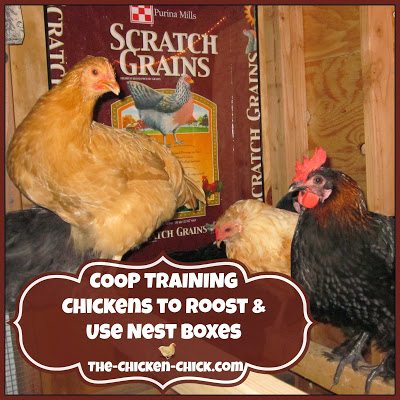
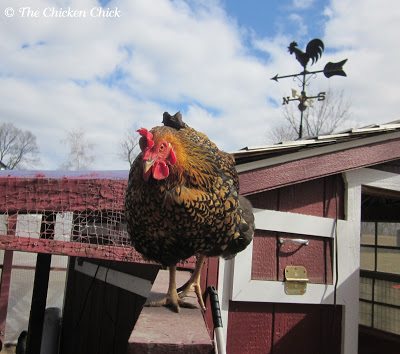
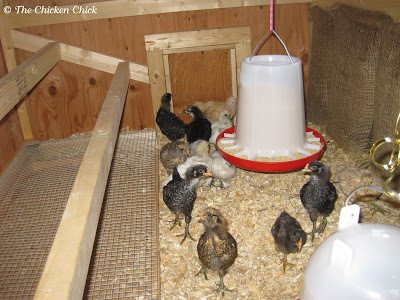
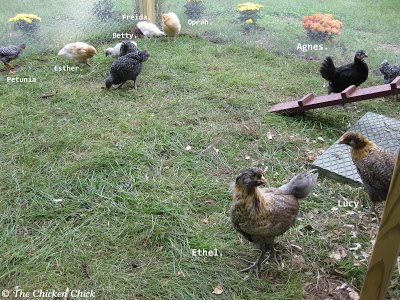
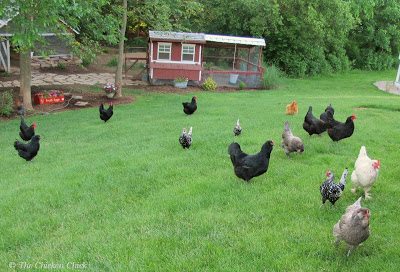
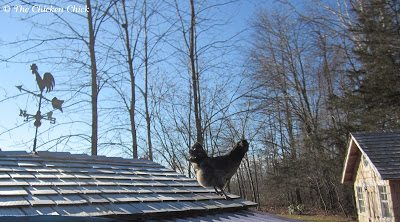
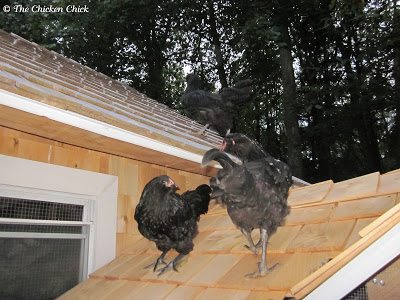
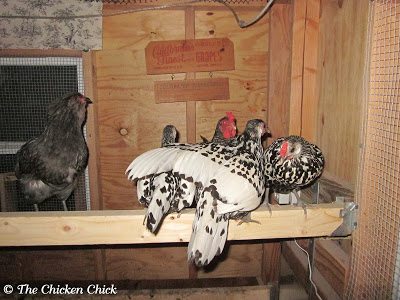





























I have gotten into a discussion with someone who picks up eggs in the morning. I don't understand morning egg pickup. In general, they don't lay at night, and in fact my old antique laying boxes have a bar that can be put up in the evening (after I do my last egg pickup of the day) to keep them out of the boxes at night. Do you feel that it is good practice to keep the chickens out of the laying boxes at night?
Since we moved the clocks back, three of our seven hens have refused to go into the coop at night. We have to chase and grab them to get them in. Nothing else has changed. Would love any ideas on how to get them back in the coop!
If they're not egg-laying yet, block off the nest boxes so they cannot get into them. You may have to put them on the roosts after dusk nightly for a week or two, but they should get the drift.
My chickens love scratch!
My chickens use their nest boxes and come into the coop by dark but sleep huddled up in the corner rather than using their roost. Do you think a week in the coop would help this?